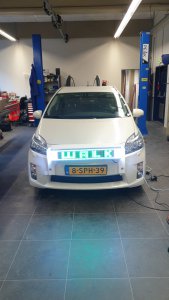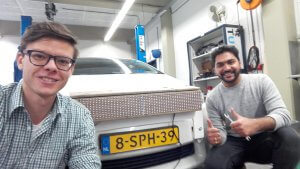VR and Field Study to analyse interaction between pedestrians and autonomous vehicles
A lot of research is being focussed on the interaction between smart infrastructure and autonomous vehicles, on vehicle-to-vehicle communication or on the interaction between vehicles and their drivers. However, little is known about the interaction with other road users outside the vehicle. This interaction with road users such as cyclists and pedestrians is of great importance, since this group is relatively vulnerable and people and robot cars will – literally – have to coexist on the road in the future.
One of the main goals of this research is to determine how self-driving vehicles influence pedestrian behaviour. In the absence of conventional interaction between the driver and the road user, various “external human-machine interfaces” (eHMI), attached to the vehicle, are tested for their effectiveness and safety by means of a study on public roads.

Field tests can pose a risk to pedestrians, they can be costly and are sometimes cumbersome to perform. Virtual Reality techniques such as VR glasses and motion detection can also be used to simulate traffic scenarios. This is a proven efficient, safe and cost-effective technique for simulations. However, whether the results are realistic and effective enough to reliably test the interaction between autonomous vehicles and pedestrians has not yet been proven.
Both issues are addressed in our research: validating different types of eHMI and comparing different test methods. The main research questions of this study are: Does the presence of an external human machine interface increase safety and traffic flow compared to the presence of an active driver in terms of safety distance? And how do pedestrian performance in terms of speed and distance perception and behaviour in Virtual Reality (VR) differ from reality?
The Research lab Automated Driving Delft (RADD) helps us to realize our study by providing us technical equipment and support with the experiments.

Rakshit Agarwal & Marc Barendse – TU Delft
Are you interested in participating in the study or would you like more information? Then please contact us via:
https://www.linkedin.com/in/rakshit-agarwal-432173b0/
https://www.linkedin.com/in/marc-barendse/
Have you ever been sitting in the back of a car and tried to read a book? Or tried to watch a video on your phone? There are people that are able to do this for a long time, but after a while it starts to affect everybody: nausea.
Car sickness created by the use of autonomous cars is an intriguing subject within the field. This is why Tugrul Irmak, Ph.D. within the faculty of 3mE of Delft University of Technology, is conducting a research about comfort during a (autonomous) car ride, mainly focussing on car sickness. In the last month he performed his second experiment related to this, this time also implementing the effects of using multimedia during a car ride.
The RADD hopes that the results given by this research will contribute to further developments within the field.
From the master program Systems and Control a student is looking for a master graduation project on automated driving, performed using the facilities of RADD.
If you have a project or know someone who does, please send an email to: info@raddelft.nl
More information of the masters program System and Control
A way to improve the performance of the traffic network is by the means of providing the cyclists with a speed advise. This could be in the form of an application on your mobile phone. Currently, the problem in the Netherlands is the fact that the traffic lights are regulated by the traffic supply and it is therefore complicated to predict the waiting times.
In cooperation with Technolution and the municipality of Rotterdam the possibilities are explored for this application.
This research is performed for the research theme: Traffic Network Performance and Traffic Management by IRT Automated Vehicles
